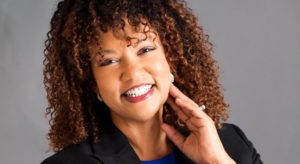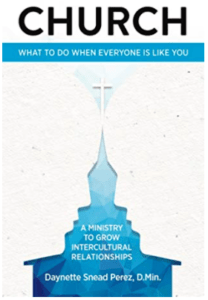The biblical command to welcome the stranger must be applied not only to immigrants and refugees but also to the way church members relate to demographically diverse people in their own congregations and communities, according to Daynette Snead Perez.
Her new book, Church: What to Do When Everyone Is Like You, functions as a manual to assist Christians in widening their gospel witness by forging relationships with previously unapproached ethnic, gender, generational and social class groups, which she also refers to as cultures.

Daynette Snead Perez
“Culture is a huge lens that will make us one,” said Snead Perez, domestic disaster response coordinator for the Cooperative Baptist Fellowship and founder and CEO of DIASPRA, a Charlotte, N.C.-based ministry that guides pastors and churches through the development of inclusive discipleship outreach.
Becoming one, she said, doesn’t refer to merging cultural identities, nor are her book and ministry about creating multicultural churches.
“’Multicultural’ means different people are in the room, but not necessarily in conversation with each other. That’s why I say ‘intercultural,’ which means there is an exchange of cultures,” she explained. “And it means we are forming relationships that are not transactional.”
Huge cultural differences can divide individuals within congregations as well as churches from surrounding neighborhoods, she said.
And those walls aren’t always erected along ethnic or racial lines. “If you look at it generationally, let’s say you have a community that is 50% Boomer, 25% Millennial and 25% Gen Z, but the church is 85% Boomer. That gives you a lens into who’s in the community and who’s not worshiping in the church.”
 The book blends Bible stories with a series of self-assessment tools, including journaling prompts and lesson challenges, that enable individuals and participants in small or large groups to identify ministry areas that can turn strangers into friends.
The book blends Bible stories with a series of self-assessment tools, including journaling prompts and lesson challenges, that enable individuals and participants in small or large groups to identify ministry areas that can turn strangers into friends.
“When a congregation is talking about choosing a direction in ministry, they can look at the demographics in their church to determine the ministries that are needed to serve ethnic, gender, generational and other cultures,” she said. “You will also be able to determine how in line, or out of line, your church is with the community.”
A key component of the process is for individuals to use the approach in how they develop their own friendships. “If we are building intercultural relationships in life, we can also build them in ministry. But we have to start with ourselves.”
Moving into those spaces can be extremely unsettling for Christians, ministers and congregations, Snead Perez added. “Most of us feel suited to be in comfort, but we need to reflect on how we can move from comfort to discomfort in order to serve on the bleeding edge of Christ and to move from the sanctuary to the community. We are not called to serve in comfort. We are called to serve.”
The furthest some churches go is to schedule events with differently cultured congregations. “But what’s next? What comes after the dinners and the conversations and the pulpit swaps? I believe the churches are saying we need a road map for our journey to becoming the inclusive community we are seeking to become,” she said.
“The unwillingness of a ministry’s leadership to adjust to the changes occurring on the outside of the church building leads to the ultimate death of the ministry.”
There are consequences when efforts are not made to engage other cultures, Snead Perez warns in her book. “The unwillingness of a ministry’s leadership to adjust to the changes occurring on the outside of the church building leads to the ultimate death of the ministry. When ministry responds to what is happening on the outside of the ministry, the way an egg responds to the warmth of an incubator, it can grow from the inside, expand its outreach, and continue to serve the church and community.”
The outlook also can be grim for churches that do not examine how, and with whom, they interact, the book adds: “If a congregation is not willing to change the ways in which it builds relationships, its survival is limited. Without growing relationships, church outreach slips away as the community changes.”
Snead Perez said she saw these dynamics at work when she served as pastor of a Burmese church in North Carolina for three years. “I experienced what it was like to be the other in a single-race congregation.”
She said her book builds on that experience and on the lessons learned coaching pastors and churches through the challenges of widening the diversity of their ministries. “Each chapter is written as a journey that allows each person and congregation to reflect on how they are building relationships in their own lives.”
The most surprising aspect of the process for many is learning that they don’t have to go across town or around the world to serve or befriend someone from a different culture, she said. “The stranger can be someone you have known for years but never engaged.”
“We have to move beyond our traditional understanding of welcoming the stranger. It’s not about race or ethnicity, it’s about humanity.”
Related articles:
The church’s missional focus: Tourist, traveler or pilgrim? | Opinion by Bill Wilson
On social capital, churches often do one part well and one part not well | Analysis by Brian Foreman and Justin Nelson


